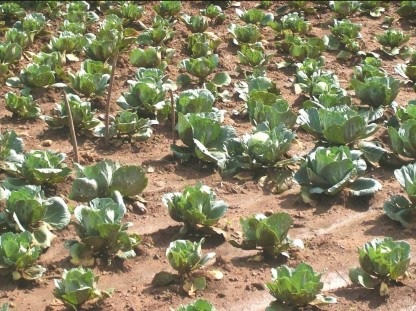Discussion
Soil and foliar application of Gloria Biosol was significantly superior over organic control in plant height, number of outer leaves per plant, leaf area, number of inner leaves per head and yield attributes, microbial population in soil, increase in the activities of soil dehydrogenase (15-54%) and soil phosphatase (6-18%), soil N, K, Cu and Mn and cabbage TSS (41%), ascorbic acid (11%), phenols (18%), crude protein (16%), N (16%), S (71%), K (22%), P (22%), Cu (13%), Zn (8%), Mn (9%) and Fe (4%) showed significant increase over organic control. Soil and foliar application of AH ash significantly increased soil P, Zn and Fe. Significant reduction was observed in the incidence of black rot (29-55%), black spot of leaf (39-73%), insect attack (head borer(18-69%), diamond back moth larvae (25-64%) and Spodoptera litura larvae (40-62%) per plant due to soil and foliar application of Gloria Biosol and different homa treatments. |
Summary and Conclusion
- Morphological characters like plant height, number of outer leaves per plant, leaf area, dry matter production and number of inner leaves per head and diameter of cabbage head were enhanced due to different homa treatments.
- There were significant differences in the surface area (cm2) of cabbage head among different treatments. It increased by 85 per cent in Gloria Biosol (a special bio-digester prepared for this study) treatment, 61 per cent in Agnihotra homa ash and 46 per cent in Om Tryambakam homa ash treatments when compared with organic control without homa. However, organic control and absolute control with homa, Non-homa ash and conventional control treatments did not differ significantly from organic control without homa.
- There were significant differences in the days taken for initiation of cabbage head formation among different treatments. It was 40 days in organic control not exposed to homa atmosphere, 30 days in Gloria Biosol treatment, 35 days in each in both homa ash treatments, 41 days in conventional control and 39 days in organic control exposed to homa atmosphere. However, only Gloria Biosol and Agnihotra homa ash differed significantly from organic control without exposure to homa.
- There were significant differences in the days taken for maturity of cabbage head among different treatments. It was 62 days in Gloria Biosol treatment, 76 days each in conventional and organic control not exposed to homa atmosphere and 74 days in organic control exposed to homa atmosphere and 66 and 68 days in Agnihotra homa ash and Om Tryambakam homa ash treatments, respectively. However, only Gloria Biosol (18%) and Agnihotra homa ash treatments (12%) differed significantly in taking less number of days for maturity of cabbage head from organic control without exposure to homa 76 days).
- Differential response was observed in cabbage head weight due to different treatments. It was significantly higher in the best homa treatment, Gloria Biosol (53%) followed by Agnihotra homa ash (35%) and Om Tryambakam homa ash (19%) treatments as compared to organic control not exposed to homa atmosphere. However, the organic control exposed to homa atmosphere, Non-homa ash and conventional control did not differ significantly from organic control not exposed to homa atmosphere.
- Noteworthy was increase in cabbage yield by 4.14 t per ha due to Gloria Biosol treatment (36.84 t/ha) which was the best among homa treatments and showed 15 per cent increase over organic control not exposed to homa (32.06 t/ha) but was non significant when compared with the control exposed to homa atmosphere (32.70 t/ha). The yields from absolute control with homa, Non-homa ash, Om Tryambakam homa ash and conventional control did not differ significantly among themselves and from organic control not exposed to homa atmosphere.
- Soil macro nutrient status registered increase (N, 9-15 %; K, 5-23 % and P, 8-50 %) over organic control exposed to homa atmosphere due to different homa treatments. However, when compared with control without homa atmosphere, only both the ashes and Gloria Biosol differed significantly.
- Soil micro nutrient status also registered increase (Cu, 4-16%; Zn, 10-8%; Mn, 11-15% and Fe, 12-35%) as compared to organic control exposed to homa atmosphere due to different homa treatments. However, when compared with control without homa atmosphere, only both the ashes and Gloria Biosol differed by showing significant increase in all the micro nutrients but Non-homa ash treatment did so in Mn and Fe content only.
- Significant increase in the population of bacteria (9-40%), fungi (11-55%) and actinomycetes (21-38%) in the soil was observed due to different homa treatments including Gloria Biosol as compared with control without homa treatment.
- Significant increase in the activities of soil dehydrogenase (15-54%) and phosphatase (6-18%) were observed in different homa treatments as compared with organic control not exposed to homa treatment but organic control with homa and conventional control did not differ significantly.
- Increase in quality parameters of cabbage like TSS (25-41%), ascorbic acid (7-11%), phenols (5-18%), nitrogen (5-16%), crude protein (5-16%), sulphur (36-71%), potassium (10-22%), phosphorus (15-22%) micronutrients like Cu, Zn, Mn and Fe (8-13%, 6-8%, 8-9% and 4%), respectively was registered due to different homa treatments as compared to organic control not exposed to homa atmosphere.
- Decrease in the incidence of black rot (29-55%) and black spot of leaf (39-73%), head borer (18-69%), number of diamond back moth larvae per plant (25-64%) and Spodoptera litura larvae per plant (40-62%) were observed due to different homa treatments as compared with organic control not exposed to homa treatment but organic control with homa and conventional control did not differ significantly.
- Notable among the observations was increase in sulphur content of cabbage head. Different homa treatments inclusive of both the homa ashes and Gloria Biosol registered very high increase when compared with organic control exposed to homa atmosphere, conventional control and non-homa organic control (45–60%, 54–85% and 43–71%), respectively.
- Soil and foliar application of Gloria Biosol was found to be more effective than other homa treatments. Om Tryambakam homa ash was also effective like Agnihotra homa ash. Non-homa ash was found to be least effective in cabbage cultivation.
The present study demonstrates that Homa organic farming practices not only heal the atmosphere by lowering the incidence of pest and diseases but also take care of health of the soil, plant and its produce.
Thesis details
Sachin Hattalli (Author)
M.Sc (Agri) (Degree)
Plant Biochemistry (Department)
University of Agricultural Sciences, Dharwad (Institute)
AC, Dharwad-580005 Karnataka State, India (Place)
2011 (Year submitted)
Th10329 (Accession No)
University Library, UAS, Dharwad
Dr. P.W. BASARKAR (Major Advisor)
View the full paper |





